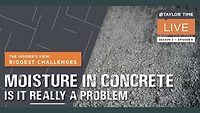Tackling the Moisture Issue




Moisture issues, one of the biggest challenges that Fuse Alliance members face each day, have become even more challenging over the last couple of years. We believe this is because there has never been a time where more new products and product types are being introduced, and the industry is moving more and more to hard surface products that are more sensitive to subfloor moisture than soft surface products. Also, we have much to learn about new types of products such as the multilayer category of flooring which can be described as rigid core, stone plastic composite (SPC), wood plastic composite (WPC), and other names.
There has also been a flurry of new introductions in high-moisture adhesives, floor patches, moisture mitigation systems, concrete curing compounds, floating floor systems and more.
Flooring manufacturers are entering the market with products that can be installed in high-moisture environments. They call them “high-moisture solutions.” However, products that can be installed in a high-moisture environment do not solve the moisture problem. They cover the floor but the moisture is still there. This is particularly problematic with products that are non-permeable.
With the plethora of new systems available, there seems to be no distinction between new slabs and old slabs, or to put it another way, new construction and renovation. If we are getting high moisture readings from the slab of a renovation project, that most likely means there is either no vapor retarder or a compromised vapor retarder underneath the slab. If you then are encapsulating the slab with a non-permeable product, you are sealing the floor and trapping the moisture underneath. This could lead to an installation failure in the future. If we are dealing with new construction, the risk is not as great because there will be a vapor retarder underneath the slab and the concrete will eventually dry out.
There are some products on the market that “breathe” and allow moisture to pass through. Those products are best used in a renovation project. If moisture must be mitigated, there are many good systems on the market. When you cover up moisture and don’t seal the concrete, you are subjecting an environment to mold, especially if water gets in the walls. Drywall is a great host for mold and if it develops post installation, the flooring contractor is responsible.
Oftentimes we become “adversaries” to our customer when we inform them we won’t install a manufacturer’s high-moisture solution even though the moisture test results are below the manufacturer’s published standard. Again, we are going to push back when an old slab is involved because moisture is entering the concrete from below due to no vapor retarder. These jobs must be mitigated, and the systems of choice utilize two-part epoxies.
At Fuse, we believe strongly in partnering with our suppliers. We simply want to be cautious by drawing the line between new construction and renovation.
This article only touches the surface of today’s challenges with moisture. Any Fuse member can take you through our moisture CEU which addresses this topic in much greater detail. Our goal is to partner with our customers to fix the problem before it becomes a bigger and more expensive problem. By educating our clients up front, we avoid costly delays and problems in the future.
Looking for a reprint of this article?
From high-res PDFs to custom plaques, order your copy today!











